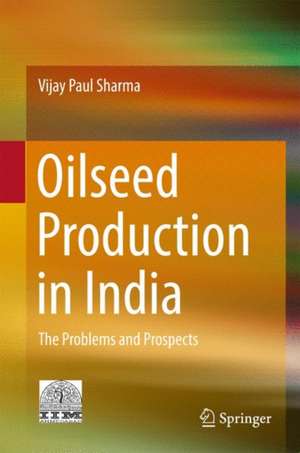Oilseed Production in India: The Problems and Prospects
Autor Vijay Paul Sharmaen Limba Engleză Hardback – 21 apr 2017
This book analyses the performance and potential of India’s oilseed sector, identifies the major constraints facing the industry and suggests options for increasing the country’s oilseed production and productivity, taking into account the changing policy environment, increasing demand, slow growth in domestic production and rising imports.
India as the world’s largest producer of oilseeds, accounts for about 7-8 per cent of global vegetable oil production. However, the growth in domestic production has not kept pace with the growth in demand. Low yields and high production and market risks due to lack of irrigation facilities and effective risk management have been responsible for widening the demand-supply gap over the years, and the country now imports more than half of its oilseed for domestic consumption. The Technology Mission on Oilseeds (TMO), launched in the mid-1980s, helped achieve self-sufficiency in edible oil production through the spread of technology and the provision of market support. However, increasing demand for edible oils necessitated imports in large quantities, leading to a substantial drain on foreign exchange. Given the competing demands on agricultural land from various crops and enterprises, the production of oilseeds can be increased only if productivity is improved significantly and farmers receive remunerative prices and have assured market access. However, farmers face various constraints in oilseed production; several biotic, abiotic, technological, institutional and socio-economic constraints inhibit exploitation of the full yield potential of crops, which need to be addressed.
The book explores these issues using data collected from about 2,000 oilseed growers: 490 soybean farmers, 316 rapeseed-mustard growers, 470 groundnut farmers, 250 sesamum farmers and 470 sunflower growers from selected Indian states. It would be of immense use for scholars and policy makers alike who are working in thisfield.
India as the world’s largest producer of oilseeds, accounts for about 7-8 per cent of global vegetable oil production. However, the growth in domestic production has not kept pace with the growth in demand. Low yields and high production and market risks due to lack of irrigation facilities and effective risk management have been responsible for widening the demand-supply gap over the years, and the country now imports more than half of its oilseed for domestic consumption. The Technology Mission on Oilseeds (TMO), launched in the mid-1980s, helped achieve self-sufficiency in edible oil production through the spread of technology and the provision of market support. However, increasing demand for edible oils necessitated imports in large quantities, leading to a substantial drain on foreign exchange. Given the competing demands on agricultural land from various crops and enterprises, the production of oilseeds can be increased only if productivity is improved significantly and farmers receive remunerative prices and have assured market access. However, farmers face various constraints in oilseed production; several biotic, abiotic, technological, institutional and socio-economic constraints inhibit exploitation of the full yield potential of crops, which need to be addressed.
The book explores these issues using data collected from about 2,000 oilseed growers: 490 soybean farmers, 316 rapeseed-mustard growers, 470 groundnut farmers, 250 sesamum farmers and 470 sunflower growers from selected Indian states. It would be of immense use for scholars and policy makers alike who are working in thisfield.
| Toate formatele și edițiile | Preț | Express |
|---|---|---|
| Paperback (1) | 554.42 lei 38-44 zile | |
| Springer India – 25 iul 2018 | 554.42 lei 38-44 zile | |
| Hardback (1) | 644.18 lei 6-8 săpt. | |
| Springer India – 21 apr 2017 | 644.18 lei 6-8 săpt. |
Preț: 644.18 lei
Preț vechi: 757.85 lei
-15% Nou
Puncte Express: 966
Preț estimativ în valută:
123.26€ • 128.71$ • 101.79£
123.26€ • 128.71$ • 101.79£
Carte tipărită la comandă
Livrare economică 16-30 aprilie
Preluare comenzi: 021 569.72.76
Specificații
ISBN-13: 9788132237167
ISBN-10: 8132237161
Pagini: 227
Ilustrații: XXIII, 197 p. 36 illus.
Dimensiuni: 155 x 235 x 14 mm
Greutate: 0.52 kg
Ediția:1st ed. 2017
Editura: Springer India
Colecția Springer
Locul publicării:New Delhi, India
ISBN-10: 8132237161
Pagini: 227
Ilustrații: XXIII, 197 p. 36 illus.
Dimensiuni: 155 x 235 x 14 mm
Greutate: 0.52 kg
Ediția:1st ed. 2017
Editura: Springer India
Colecția Springer
Locul publicării:New Delhi, India
Cuprins
Chapter 1: Introduction.- Chapter 2: Coverage, sampling Design and Methodology.- Chapter 3: Overview of Oilseeds Sector: Current Status and Growth Behaviour.- Chapter 4: Performance of Soybean: Recent Trends, Prospects and Constraints.- Chapter 5: Performance of Rapeseed and Mustard: Recent Trends, Prospects and Constraints.- Chapter 6: Performance of Groundnut: Recent Trends, Prospects and Constraints.- Chapter 7: Performance of Sunflower: Recent Trends, Prospects and Constraints.- Chapter 8: Performance of Sesamum: Recent Trends, Prospects and Constraints.- Chapter 9: Performance of Safflower: Recent Trends, Prospects and Constraints.- Chapter 10: Summary, Concluding Observations and Policy Implications.
Notă biografică
Prof. Sharma is currently Chairman, Commission for Agricultural Costs and Prices (CACP), Ministry of Agriculture and Farmers Welfare, Govt. of India. He was a Professor in Centre for Management in Agriculture (CMA), Indian Institute of Management, Ahmedabad (IIMA) when this study was completed. He has held several important positions including Chairman, Centre for Management in Agriculture during 2005-2008 and 20102012 and Chairman, Post Graduate Programme (equivalent to MBA) in Food and Agribusiness Management (PGP-FABM) from 2002 to 2004 and 2013 to 2015 at IIMA. He was International Consultant to Food and Agriculture Organization of the United Nations (FAO), FAO Regional Office for Near East and North Africa, in Riyadh, Saudi Arabia during Oct. 2015 to Jan. 2016 and Advisor to USAID’s Economic Reforms Project in the Central Asian Countries in Tashkent, Uzbekistan in 2005.
He has been a consultant to many national and international organisations in the agri-food and development sector and is a member/chairman of several national and state-level committees. His research and consulting interests focus on agricultural and food policies, international trade issues including the World Trade Organization (WTO), agribusiness competitiveness and strategic planning, pricing policy, subsidies, rural infrastructure, and food safety and quality issues. He teaches courses on agricultural and food policy, international trade and commodity trading.
Textul de pe ultima copertă
This book analyses the performance and potential of India’s oilseed sector, identifies the major constraints facing the industry and suggests options for increasing the country’s oilseed production and productivity, taking into account the changing policy environment, increasing demand, slow growth in domestic production and rising imports.
India as the world’s largest producer of oilseeds, accounts for about 7-8 per cent of global vegetable oil production. However, the growth in domestic production has not kept pace with the growth in demand. Low yields and high production and market risks due to lack of irrigation facilities and effective risk management have been responsible for widening the demand-supply gap over the years, and the country now imports more than half of its oilseed for domestic consumption. The Technology Mission on Oilseeds (TMO), launched in the mid-1980s, helped achieve self-sufficiency in edible oil production through the spread of technology and the provision of market support. However, increasing demand for edible oils necessitated imports in large quantities, leading to a substantial drain on foreign exchange. Given the competing demands on agricultural land from various crops and enterprises, the production of oilseeds can be increased only if productivity is improved significantly and farmers receive remunerative prices and have assured market access. However, farmers face various constraints in oilseed production; several biotic, abiotic, technological, institutional and socio-economic constraints inhibit exploitation of the full yield potential of crops, which need to be addressed.
The book explores these issues using data collected from about 2,000 oilseed growers: 490 soybean farmers, 316 rapeseed-mustard growers, 470 groundnut farmers, 250 sesamum farmers and 470 sunflower growers from selected Indian states. It would be of immense use for scholars and policy makers alike who are working in this field.
The book explores these issues using data collected from about 2,000 oilseed growers: 490 soybean farmers, 316 rapeseed-mustard growers, 470 groundnut farmers, 250 sesamum farmers and 470 sunflower growers from selected Indian states. It would be of immense use for scholars and policy makers alike who are working in this field.
Caracteristici
Addresses oilseed production problems in India Suggests ways to improve the country’s oilseed production and productivity Discusses the major policy initiatives that have significantly impacted the development of the Indian oilseed sector Includes supplementary material: sn.pub/extras










